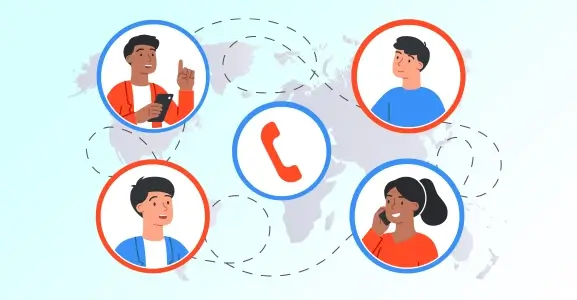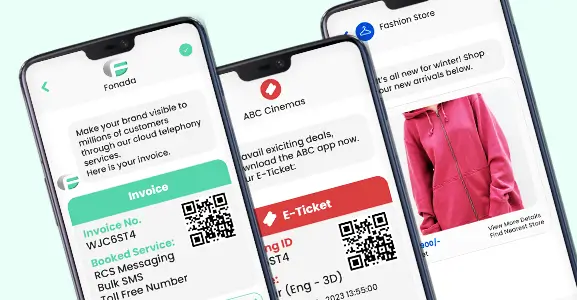When you’re operating a business, call routing may not be the first thing on your mind at the start of your day. However, when inbound calls aren’t managed effectively, it can quickly turn into an urgent matter that needs immediate attention.
One of the biggest concerns for a business owner is the possibility of potential customers reaching dead ends, encountering neglected voicemail boxes, or speaking with the wrong individuals on their team. But there’s no need to worry because call routing can handle incoming calls precisely the way you want.
As a fundamental feature of a cloud based phone system, call routing directs calls based on specific conditions, such as the purpose of the call, the day of the week, the time of day, agent skills, and many other factors.
What Is Call Routing?
Call routing is a telecommunications process that directs incoming phone calls to specific destinations or endpoints based on predefined criteria. The primary goal of call routing is to ensure that incoming calls are efficiently and accurately directed to the appropriate destination, which could be a particular phone extension, department, individual, or voicemail box. This process helps manage and optimize the flow of incoming calls within an organization or network.
How Call Routing Works ?
Call routing directs incoming calls to the most appropriate destination within an organization. It relies on predetermined rules, often based on factors like caller input, time of day, or agent availability. Automated systems use IVR menus, caller ID, and other criteria to route calls to specific extensions, departments, or agents, ensuring efficient and effective call handling.
Modern call routing often utilizes advanced technologies like AI and machine learning for more intelligent routing decisions.
Types Of Call Routing
Call routing can be categorized into various types based on different criteria and methods. Here are some common types of call routing:
1. Skills-Based Routing
In skills-based routing, incoming calls are directed to agents or representatives with specific skills, expertise, or qualifications that match the caller’s needs. This ensures that callers are connected to the most suitable agent.
2. Time-Based Routing
Time-based routing routes calls differently depending on the time of day, day of the week, or specific date. For example, it can route calls to a 24/7 support team during non-business hours and to regular departments during business hours.
3. Geographic Routing
Geographic routing directs calls based on the caller’s geographic location. This is especially useful for businesses with multiple offices or regional call centers, ensuring that local callers are connected to nearby agents.
4. Interactive Voice Response (IVR) Routing
IVR systems present callers with automated menus and route calls based on the caller’s selections. Callers can choose from options like “Press 1 for Sales” or “Press 2 for Support.”
5. Direct Inward Dialing (DID) Routing
DID routing assigns unique phone numbers to individual employees or extensions within an organization. Callers can dial these direct numbers to reach specific individuals without going through a central switchboard.
6. Load Balancing Routing
Load balancing evenly distributes incoming calls among available agents or resources to prevent overloading any one agent or system component. This ensures fair distribution of calls.
7. Follow-Me Routing (Find-Me-Follow-Me)
Follow-Me routing allows calls to follow an individual to different devices or locations. For example, if a call isn’t answered on a desk phone, it can be routed to the person’s mobile phone.
8. Overflow Routing
Overflow routing is used when call volume exceeds capacity. It directs excess calls to secondary agents or resources, such as backup call centers or voicemail, to prevent callers from experiencing long wait times.
9. Percentage-Based Routing
Percentage-based routing allocates a percentage of incoming calls to different groups of agents. For example, 60% of calls may go to the sales team, while 40% go to the support team.
10. Least Occupied Routing
Least occupied routing directs calls to the agent or queue with the fewest calls or the shortest wait time. This helps balance the workload among agents and reduces overall call wait times.
11. Random Routing
Random routing distributes calls randomly among available agents. While it lacks specificity, it can be useful to ensure equal distribution of calls when skills or criteria are not a primary concern.
12. Priority-Based Routing
Priority-based routing assigns different priorities to calls based on criteria such as customer status or issue severity. Higher-priority calls are routed to more experienced or specialized agents.
The choice of call routing type depends on the specific needs and goals of a business or organization. Many call centers use a combination of these routing types to optimize call handling and enhance customer service.
Top 10 Benefits Of Call Routing
Call routing offers numerous benefits to businesses and organizations, enhancing efficiency, customer service, and overall communication. Here are ten key advantages of implementing call routing:
- Improved Customer Service: Call routing ensures that callers are directed to the most qualified agents or departments, resulting in faster issue resolution and higher customer satisfaction.
- Reduced Wait Times: By efficiently distributing calls, call routing minimizes wait times for callers, reducing frustration and the likelihood of abandoned calls.
- Enhanced Call Management: It allows businesses to handle high call volumes seamlessly, preventing bottlenecks and ensuring that no calls go unanswered.
- Personalized Customer Experience: Call routing enables businesses to tailor greetings and routing options based on caller data, providing a more personalized and professional experience.
- Cost Savings: Efficient routing reduces the need for additional staff to manage calls, optimizing resource utilization and potentially lowering operational costs.
- Increased Productivity: Agents receive calls that align with their skills and expertise, leading to more productive and focused interactions with customers.
- Consistency: Call routing ensures that calls are handled consistently, adhering to established protocols and maintaining brand standards.
- Flexibility: Businesses can adapt call routing strategies to changing needs, such as modifying routing rules based on business hours, holidays, or promotional campaigns.
- Multi-Channel Integration: Call routing can be integrated with other communication channels, such as email and chat, providing a unified approach to customer support and engagement.
- Data Collection and Analysis: Call routing systems often collect valuable call data, which can be analyzed to identify trends, improve processes, and make data-driven decisions to enhance customer service and efficiency.
In summary, call routing plays a crucial role in optimizing call center operations, improving customer service, and ultimately benefiting the organization by increasing productivity and cost-efficiency while enhancing the customer experience.
15 Tips On Implementing A Call Routing System
- Define Your Objectives: Clearly outline your goals and expectations for the call-routing system. Determine what you want to achieve, whether it’s reducing wait times, improving customer service, or optimizing resource allocation.
- Understand Your Audience: Analyze your customer base and their preferences. Tailor call routing to match customer needs, whether it’s language preferences, specific inquiries, or desired outcomes.
- Map Call Flows: Create a visual map of how calls will flow through the system. Identify decision points, such as IVR menus or agent queues, and design routing paths accordingly.
- Prioritize Calls: Assign importance levels to different call types. Ensure that high-priority calls are routed to skilled agents or specialists for prompt resolution.
- Implement Intelligent Routing: Utilize AI and machine learning algorithms to make real-time routing decisions based on caller data, historical interactions, and agent availability.
- Personalize the Experience: Offer callers options to reach their preferred department or agent, enhancing customer satisfaction. Use caller information to customize greetings and responses.
- Optimize Agent Skills: Match caller needs with agent skills to improve first-call resolution rates. Provide training and resources to agents for better handling of specific call types.
- Monitor and Analyze: Continuously track and analyze call routing performance. Use data to identify bottlenecks, refine routing rules, and make improvements.
- Test and Refine: Before full implementation, conduct thorough testing to ensure the system functions as intended. Gather feedback from agents and customers to make necessary adjustments.
- Scalability: Choose a call-routing solution that can easily adapt to your organization’s growth and changing needs. Ensure it can handle increased call volumes without compromising quality.
- Disaster Recovery: Develop a plan for handling calls in case of system failures or outages. Implement backup routing options to minimize disruptions.
- Provide Training: Train agents and staff on how to use the call-routing system effectively and troubleshoot common issues.
- Customer Feedback: Solicit feedback from callers to gauge their experience with the call-routing system and make improvements accordingly.
- Regulatory Compliance: Ensure that your call-routing system complies with relevant regulations, such as data privacy laws and call recording requirements.
- Regular Maintenance: Schedule regular maintenance to keep the system running smoothly. Update routing rules and adapt to changing business needs.
Factors Influence Call Routing Process:
You can route calls according to several different rules (or criteria), including the following:
- Auto Attendant Selections: What option does the caller choose from the menu? Do they have issues with your product? Or do you simply look for information? Redirect the call as appropriate.
- Caller Identification: Use caller ID to recall previous interactions with customers. Verify the items they purchased from you and then transfer the call to the appropriate department.
- Agent Skill: Your system should route calls to the best person.
- The Time of Day: Caller and contact center call routing are in separate time zones.
- IVR: Interactive Voice Response: Your system can integrate ML and AI to determine how to best direct a call based on the caller’s stated requirements.
Best Call Routing Practices
Here are some guidelines for developing an efficient call-routing strategy:
- Maintain simplicity in pre-recorded IVR prompts
- Integrate your routing system with CRM software.
- Provide callers queue position and expected wait periods while on hold.
- Provide callers with the choice of an automatic callback.
- Make it simple to contact a live representative when needed.
- To improve first-contact agent availability, create call groups.
- Offer options for language-based routing
- Use automated customer questionnaires
- Consider adding more VoIP call routing choices and IVR menu options during busy times.
Conclusion:
Both customer happiness and contact center productivity depend on efficient teams call routing. A cloud-based VoIP call routing solution lets you handle outgoing and incoming calls online. Customers are protected because malicious actors are prohibited from using the service. You can increase first-call resolution and customer satisfaction through call routing. It’s time to upgrade your phone service provider if it doesn’t support call routing.
Call routing enhances prompt customer satisfaction and revenue generation. Instead of reaching voicemail, calls are addressed by the relevant staff at the appropriate time.
FAQs
Call routing is a telecommunications process that directs incoming calls to their intended destination within a phone system or network. It ensures that calls are properly directed to the appropriate extensions, departments, or individuals.
Call routing is important for efficiently managing incoming calls, reducing call handling time, and improving customer service. It helps ensure that callers reach the right person or department, enhancing overall communication effectiveness.
Effective call routing improves customer service by reducing wait times, connecting callers to the right agents, and ensuring consistent service quality.
Yes, call routing can be highly customized to meet the specific needs of different businesses. This includes defining routing rules, creating IVR scripts, and configuring routing based on business hours and holidays.
Load balancing in call routing distributes incoming calls evenly among available agents or resources to prevent overloading any particular agent or system component.
Voice over Internet Protocol (VoIP) has transformed call routing by enabling more flexible and cost-effective routing options. VoIP service providers allows for routing calls over the internet, making it easier to implement complex routing strategies.
Common challenges in call routing include maintaining system reliability, preventing bottlenecks during high call volumes, and ensuring that routing rules are appropriately configured to meet changing business needs.
Call routing stands as a pivotal component within call center software systems. Concerning iPhones, call routing involves the procedure of guiding (redirecting) incoming calls to an alternate number designated by the user (can be activated via ‘Settings’ > ‘Phone’ > ‘Call Forwarding’) or directing them to voicemail in alignment with the user’s preferences.
Call routing in a call center is the process of directing incoming calls to the most appropriate agent, department, or resource within the center. It ensures that each call is handled efficiently and reaches the right destination.
Effective call routing is essential to optimize the use of available resources, reduce wait times for callers, enhance customer satisfaction, and streamline the workflow within the call center.
The primary methods include skills-based routing, time-based routing, geographic routing, interactive voice response (IVR), and direct inward dialing (DID). These methods allow for routing calls based on various criteria.
There are the following call routing systems:
- Round-robin Routing
- Least Occupancy Routing
- Skills-based Routing
- Intelligent Call Routing
- Business Rules Routing
- Time-based Routing
- Predictive Behavioral Routing
- Sequential Routing
- Outbound Routing
Call routing is a customer support tool for a business telephone system that queues incoming calls and routes them depending on pre-set rules. Calls are routed before the recipient of the call responds.
A call flow is a plan for handling calls from when they come into the phone system until the end. Call flows can manage complex call situations and improve customer service.
Direct routing uses the phone keypad or speech recognition to navigate the menu. The IVR lets customers access pre-recorded information.
Call routing lets customers get phone system information without an operator. IVR intelligently guides callers through alternatives while it routes calls to the agents based on the organizational criteria.
Call routing effectively receives and routes business calls to extensions or groups depending on your requirements. Call centers route calls independently, but the process is similar.
- Qualifying Phase
- Call Queueing Phase
- Call Distribution Phase

Dec 11, 2024
Top Contact Center Optimization Tools For 2024
“A thriving business knows how to fetch maximum output from limited resources by optimizing ca... Read More
Nov 13, 2024
What Is Brand Communication? CPaaS Role Explained
Did you ever wonder why some advertisements grab your attention instantly, while others do not? The... Read More
Nov 01, 2024
What Is Automated Messaging And How Does It Work?
Automated messaging or text automation empowers businesses and marketing professionals to connect wi... Read MoreLatest Updates
From Fonada
Industry Insights, Trends, Innovations, Updates, and Case Studies from Industry Experts
View
Customer
Reviews
Discover why our customers love us - read their authentic and heartfelt reviews!
View
Case
Studies
Explore real-life scenarios, offering analysis, and solutions to practical challenges
View
Convert Leads Into Sales With Fonada
Trusted CPaaS Solution Provider








